Probing the Conformational Restraints of DNA Damage Recognition with β-L-Nucleotides
Abstract
:1. Introduction
2. Results
2.1. dNMP Incorporation by DNA Polymerases Opposite βLdNs
2.2. Kinetic Basis for dNMP Incorporation Preference
2.3. Enzyme-Dependent Recognition of βLdNs as Opposite Nucleotides by DNA Glycosylases
2.4. βLdNs Are Resistant to AP Endonucleases
2.5. Repair of βLdNs in Human Cells
3. Discussion
4. Materials and Methods
4.1. Enzymes, Oligonucleotides, Plasmids and Cells
4.2. DNA Polymerases Standing-Start Assay
4.3. DNA Polymerases Steady-State Kinetics
4.4. DNA Glycosylase Assay
4.5. Steady-State Fpg Kinetics
4.6. Singe-Turnover OGG1 Kinetics
4.7. AP Endonuclease Assay
4.8. Transcription Mutagenesis Experiments
4.9. Structure Modeling
Supplementary Materials
Author Contributions
Funding
Institutional Review Board Statement
Informed Consent Statement
Data Availability Statement
Acknowledgments
Conflicts of Interest
References
- Zhang, D.Y.; Seelig, G. Dynamic DNA nanotechnology using strand-displacement reactions. Nat. Chem. 2011, 3, 103–113. [Google Scholar] [CrossRef]
- Seeman, N.C.; Sleiman, H.F. DNA nanotechnology. Nat. Rev. Mater. 2018, 3, 17068. [Google Scholar] [CrossRef]
- Goodchild, J.; Kim, B.; Zamecnik, P.C. The clearance and degradation of oligodeoxynucleotides following intravenous injection into rabbits. Antisense Res. Dev. 1991, 1, 153–160. [Google Scholar] [CrossRef]
- Agrawal, S.; Temsamani, J.; Galbraith, W.; Tang, J. Pharmacokinetics of antisense oligonucleotides. Clin. Pharmacokinet. 1995, 28, 7–16. [Google Scholar] [CrossRef]
- D’Alonzo, D.; Guaragna, A.; Palumbo, G. Exploring the role of chirality in nucleic acid recognition. Chem. Biodivers. 2011, 8, 373–413. [Google Scholar] [CrossRef]
- Young, B.E.; Kundu, N.; Sczepanski, J.T. Mirror-image oligonucleotides: History and emerging applications. Chemistry 2019, 25, 7981–7990. [Google Scholar] [CrossRef]
- Wlotzka, B.; Leva, S.; Eschgfäller, B.; Burmeister, J.; Kleinjung, F.; Kaduk, C.; Muhn, P.; Hess-Stumpp, H.; Klussmann, S. In vivo properties of an anti-GnRH Spiegelmer: An example of an oligonucleotide-based therapeutic substance class. Proc. Natl. Acad. Sci. USA 2002, 99, 8898–8902. [Google Scholar] [CrossRef]
- Williams, K.P.; Liu, X.-H.; Schumacher, T.N.M.; Lin, H.Y.; Ausiello, D.A.; Kim, P.S.; Bartel, D.P. Bioactive and nuclease-resistant L-DNA ligand of vasopressin. Proc. Natl. Acad. Sci. USA 1997, 94, 11285–11290. [Google Scholar] [CrossRef]
- Kim, K.-R.; Lee, T.; Kim, B.-S.; Ahn, D.-R. Utilizing the bioorthogonal base-pairing system of L-DNA to design ideal DNA nanocarriers for enhanced delivery of nucleic acid cargos. Chem. Sci. 2014, 5, 1533–1537. [Google Scholar] [CrossRef]
- Vater, A.; Klussmann, S. Turning mirror-image oligonucleotides into drugs: The evolution of Spiegelmer® therapeutics. Drug Discov. Today 2015, 20, 147–155. [Google Scholar] [CrossRef]
- Zhong, W.; Sczepanski, J.T. Chimeric D/L-DNA probes of base excision repair enable real-time monitoring of thymine DNA glycosylase activity in live cells. J. Am. Chem. Soc. 2023, 145, 17066–17074. [Google Scholar] [CrossRef]
- Shui, X.; McFail-Isom, L.; Hu, G.G.; Williams, L.D. The B-DNA dodecamer at high resolution reveals a spine of water on sodium. Biochemistry 1998, 37, 8341–8355. [Google Scholar] [CrossRef]
- Urata, H.; Ogura, E.; Shinohara, K.; Ueda, Y.; Akagi, M. Synthesis and properties of mirror-image DNA. Nucleic Acids Res. 1992, 20, 3325–3332. [Google Scholar] [CrossRef]
- Frauendorf, C.; Hausch, F.; Röhl, I.; Lichte, A.; Vonhoff, S.; Klussmann, S. Internal 32P-labeling of L-deoxyoligonucleotides. Nucleic Acids Res. 2003, 31, e34. [Google Scholar] [CrossRef]
- Grove, K.L.; Cheng, Y.-C. Uptake and metabolism of the new anticancer compound β-L-(−)-dioxolane-cytidine in human prostate carcinoma DU-145 cells. Cancer Res. 1996, 56, 4187–4191. [Google Scholar]
- Kukhanova, M.; Liu, S.-H.; Mozzherin, D.; Lin, T.-S.; Chu, C.K.; Cheng, Y.-C. L- and D-enantiomers of 2′,3′-dideoxycytidine 5′-triphosphate analogs as substrates for human DNA polymerases: Implications for the mechanism of toxicity. J. Biol. Chem. 1995, 270, 23055–23059. [Google Scholar] [CrossRef]
- Vyas, R.; Zahurancik, W.J.; Suo, Z. Structural basis for the binding and incorporation of nucleotide analogs with L-stereochemistry by human DNA polymerase λ. Proc. Natl. Acad. Sci. USA 2014, 111, E3033–E3042. [Google Scholar] [CrossRef]
- Lam, W.; Park, S.-Y.; Leung, C.-H.; Cheng, Y.-C. Apurinic/apyrimidinic endonuclease-1 protein level is associated with the cytotoxicity of L-configuration deoxycytidine analogs (troxacitabine and β-L-2′,3′-dideoxy-2′,3′-didehydro-5-fluorocytidine) but not D-configuration deoxycytidine analogs (gemcitabine and β-D-arabinofuranosylcytosine). Mol. Pharmacol. 2006, 69, 1607–1614. [Google Scholar] [CrossRef]
- Urata, H.; Ueda, Y.; Suhara, H.; Nishioka, E.; Akagi, M. NMR study of a heterochiral DNA: Stable Watson-Crick-type base-pairing between the enantiomeric residues. J. Am. Chem. Soc. 1993, 115, 9852–9853. [Google Scholar] [CrossRef]
- Damha, M.J.; Giannaris, P.A.; Marfey, P. Antisense L/D-oligodeoxynucleotide chimeras: Nuclease stability, base-pairing properties, and activity at directing ribonuclease H. Biochemistry 1994, 33, 7877–7885. [Google Scholar] [CrossRef]
- Blommers, M.J.J.; Tondelli, L.; Garbesi, A. Effects of the introduction of L-nucleotides into DNA. Solution structure of the heterochiral duplex d(G-C-G-(L)T-G-C-G)•d(C-G-C-A-C-G-C) studied by NMR spectroscopy. Biochemistry 1994, 33, 7886–7896. [Google Scholar] [CrossRef]
- Urata, H.; Ueda, Y.; Akagi, M. Effects of breaking homochirality on DNA structure and stability: Introduction of an L-nucleotide into DNA induces some decrease of helical stability but not critical helical distortion. Viva Orig. 2003, 31, 233–242. [Google Scholar] [CrossRef]
- Friedberg, E.C.; Walker, G.C.; Siede, W.; Wood, R.D.; Schultz, R.A.; Ellenberger, T. DNA Repair and Mutagenesis; ASM Press: Washington, DC, USA, 2006; 1118p. [Google Scholar]
- David, S.S.; O’Shea, V.L.; Kundu, S. Base-excision repair of oxidative DNA damage. Nature 2007, 447, 941–950. [Google Scholar] [CrossRef]
- Zharkov, D.O. Base excision DNA repair. Cell. Mol. Life Sci. 2008, 65, 1544–1565. [Google Scholar] [CrossRef]
- Shibutani, S.; Takeshita, M.; Grollman, A.P. Translesional synthesis on DNA templates containing a single abasic site: A mechanistic study of the “A rule”. J. Biol. Chem. 1997, 272, 13916–13922. [Google Scholar] [CrossRef]
- Strauss, B.S. The ‘A rule’ of mutagen specificity: A consequence of DNA polymerase bypass of non-instructional lesions? Bioessays 1991, 13, 79–84. [Google Scholar] [CrossRef]
- Taylor, J.-S. New structural and mechanistic insight into the A-rule and the instructional and non-instructional behavior of DNA photoproducts and other lesions. Mutat. Res. 2002, 510, 55–70. [Google Scholar] [CrossRef]
- Haracska, L.; Prakash, L.; Prakash, S. Role of human DNA polymerase κ as an extender in translesion synthesis. Proc. Natl. Acad. Sci. USA 2002, 99, 16000–16005. [Google Scholar] [CrossRef]
- Yudkina, A.V.; Zharkov, D.O. Miscoding and DNA polymerase stalling by methoxyamine-adducted abasic sites. Chem. Res. Toxicol. 2022, 35, 303–314. [Google Scholar] [CrossRef]
- Michaels, M.L.; Tchou, J.; Grollman, A.P.; Miller, J.H. A repair system for 8-oxo-7,8-dihydrodeoxyguanine. Biochemistry 1992, 31, 10964–10968. [Google Scholar] [CrossRef]
- Boiteux, S.; Coste, F.; Castaing, B. Repair of 8-oxo-7,8-dihydroguanine in prokaryotic and eukaryotic cells: Properties and biological roles of the Fpg and OGG1 DNA N-glycosylases. Free Radic. Biol. Med. 2017, 107, 179–201. [Google Scholar] [CrossRef]
- Krishnamurthy, N.; Haraguchi, K.; Greenberg, M.M.; David, S.S. Efficient removal of formamidopyrimidines by 8-oxoguanine glycosylases. Biochemistry 2008, 47, 1043–1050. [Google Scholar] [CrossRef]
- Esadze, A.; Rodriguez, G.; Cravens, S.L.; Stivers, J.T. AP-endonuclease 1 accelerates turnover of human 8-oxoguanine DNA glycosylase by preventing retrograde binding to the abasic-site product. Biochemistry 2017, 56, 1974–1986. [Google Scholar] [CrossRef]
- Kitsera, N.; Rodriguez-Alvarez, M.; Emmert, S.; Carell, T.; Khobta, A. Nucleotide excision repair of abasic DNA lesions. Nucleic Acids Res. 2019, 47, 8537–8547. [Google Scholar] [CrossRef]
- Rodriguez-Alvarez, M.; Kim, D.; Khobta, A. EGFP reporters for direct and sensitive detection of mutagenic bypass of DNA lesions. Biomolecules 2020, 10, 902. [Google Scholar] [CrossRef]
- Khobta, A.; Kitsera, N.; Speckmann, B.; Epe, B. 8-Oxoguanine DNA glycosylase (Ogg1) causes a transcriptional inactivation of damaged DNA in the absence of functional Cockayne syndrome B (Csb) protein. DNA Repair 2009, 8, 309–317. [Google Scholar] [CrossRef]
- Kim, D.V.; Diatlova, E.A.; Zharkov, T.D.; Melentyev, V.S.; Yudkina, A.V.; Endutkin, A.V.; Zharkov, D.O. Back-up base excision DNA repair in human cells deficient in the major AP endonuclease, APE1. Int. J. Mol. Sci. 2024, 25, 64. [Google Scholar] [CrossRef]
- Doi, M.; Inoue, M.; Tomoo, K.; Ishida, T.; Ueda, Y.; Akagi, M.; Urata, H. Structural characteristics of enantiomorphic DNA: Crystal analysis of racemates of the d(CGCGCG) duplex. J. Am. Chem. Soc. 1993, 115, 10432–10433. [Google Scholar] [CrossRef]
- Mandal, P.K.; Collie, G.W.; Kauffmann, B.; Huc, I. Racemic DNA crystallography. Angew. Chem. Int. Ed. 2014, 53, 14424–14427. [Google Scholar] [CrossRef]
- Mandal, P.K.; Collie, G.W.; Srivastava, S.C.; Kauffmann, B.; Huc, I. Structure elucidation of the Pribnow box consensus promoter sequence by racemic DNA crystallography. Nucleic Acids Res. 2016, 44, 5936–5943. [Google Scholar] [CrossRef]
- Simmons, C.R.; Zhang, F.; MacCulloch, T.; Fahmi, N.; Stephanopoulos, N.; Liu, Y.; Seeman, N.C.; Yan, H. Tuning the cavity size and chirality of self-assembling 3D DNA crystals. J. Am. Chem. Soc. 2017, 139, 11254–11260. [Google Scholar] [CrossRef]
- Garbesi, A.; Capobianco, M.L.; Colonna, F.P.; Tondelli, L.; Arcamone, F.; Manzini, G.; Hilbers, C.W.; Aelen, J.M.E.; Blommers, M.J.J. L-DNAs as potenital antimessenger oligonucleotides: A reassessment. Nucleic Acids Res. 1993, 21, 4159–4165. [Google Scholar] [CrossRef]
- Aramini, J.M.; Cleaver, S.H.; Pon, R.T.; Cunningham, R.P.; Germann, M.W. Solution structure of a DNA duplex containing an α-anomeric adenosine: Insights into substrate recognition by endonuclease IV. J. Mol. Biol. 2004, 338, 77–91. [Google Scholar] [CrossRef]
- Johnson, C.N.; Spring, A.M.; Desai, S.; Cunningham, R.P.; Germann, M.W. DNA sequence context conceals α-anomeric lesions. J. Mol. Biol. 2012, 416, 425–437. [Google Scholar] [CrossRef]
- Sosunov, V.V.; Santamaria, F.; Victorova, L.S.; Gosselin, G.; Rayner, B.; Krayevsky, A.A. Stereochemical control of DNA biosynthesis. Nucleic Acids Res. 2000, 28, 1170–1175. [Google Scholar] [CrossRef]
- Xiao, Y.; Liu, Q.; Tang, X.; Yang, Z.; Wu, L.; He, Y. Mirror-image thymidine discriminates against incorporation of deoxyribonucleotide triphosphate into DNA and repairs itself by DNA polymerases. Bioconjug. Chem. 2017, 28, 2125–2134. [Google Scholar] [CrossRef]
- Zahn, K.E.; Belrhali, H.; Wallace, S.S.; Doublié, S. Caught bending the A-rule: Crystal structures of translesion DNA synthesis with a non-natural nucleotide. Biochemistry 2007, 46, 10551–10561. [Google Scholar] [CrossRef]
- Obeid, S.; Blatter, N.; Kranaster, R.; Schnur, A.; Diederichs, K.; Welte, W.; Marx, A. Replication through an abasic DNA lesion: Structural basis for adenine selectivity. EMBO J. 2010, 29, 1738–1747. [Google Scholar] [CrossRef]
- Beard, W.A.; Shock, D.D.; Batra, V.K.; Pedersen, L.C.; Wilson, S.H. DNA polymerase β substrate specificity: Side chain modulation of the “A-rule”. J. Biol. Chem. 2009, 284, 31680–31689. [Google Scholar] [CrossRef]
- Beese, L.S.; Derbyshire, V.; Steitz, T.A. Structure of DNA polymerase I Klenow fragment bound to duplex DNA. Science 1993, 260, 352–355. [Google Scholar] [CrossRef]
- Vasquez-Del Carpio, R.; Silverstein, T.D.; Lone, S.; Johnson, R.E.; Prakash, L.; Prakash, S.; Aggarwal, A.K. Role of human DNA polymerase κ in extension opposite from a cis–syn thymine dimer. J. Mol. Biol. 2011, 408, 252–261. [Google Scholar] [CrossRef] [PubMed]
- Jha, V.; Ling, H. Structural basis for human DNA polymerase kappa to bypass cisplatin intrastrand cross-link (Pt-GG) lesion as an efficient and accurate extender. J. Mol. Biol. 2018, 430, 1577–1589. [Google Scholar] [CrossRef] [PubMed]
- Xia, S.; Vashishtha, A.; Bulkley, D.; Eom, S.H.; Wang, J.; Konigsberg, W.H. Contribution of partial charge interactions and base stacking to the efficiency of primer extension at and beyond abasic sites in DNA. Biochemistry 2012, 51, 4922–4931. [Google Scholar] [CrossRef]
- Beard, W.A.; Wilson, S.H. Structure and mechanism of DNA polymerase β. Biochemistry 2014, 53, 2768–2780. [Google Scholar] [CrossRef] [PubMed]
- Daube, S.S.; Arad, G.; Livneh, Z. Translesion replication by DNA polymerase β is modulated by sequence context and stimulated by fork-like flap structures in DNA. Biochemistry 2000, 39, 397–405. [Google Scholar] [CrossRef] [PubMed]
- Eckenroth, B.E.; Fleming, A.M.; Sweasy, J.B.; Burrows, C.J.; Doublié, S. Crystal structure of DNA polymerase β with DNA containing the base lesion spiroiminodihydantoin in a templating position. Biochemistry 2014, 53, 2075–2077. [Google Scholar] [CrossRef]
- Koag, M.-C.; Lai, L.; Lee, S. Structural basis for the inefficient nucleotide incorporation opposite cisplatin-DNA lesion by human DNA polymerase β. J. Biol. Chem. 2014, 289, 31341–31348. [Google Scholar] [CrossRef] [PubMed]
- Ryan, B.J.; Yang, H.; Bacurio, J.H.T.; Smith, M.R.; Basu, A.K.; Greenberg, M.M.; Freudenthal, B.D. Structural dynamics of a common mutagenic oxidative DNA lesion in duplex DNA and during DNA replication. J. Am. Chem. Soc. 2022, 144, 8054–8065. [Google Scholar] [CrossRef]
- Radhakrishnan, R.; Arora, K.; Wang, Y.; Beard, W.A.; Wilson, S.H.; Schlick, T. Regulation of DNA repair fidelity by molecular checkpoints: “Gates” in DNA polymerase β’s substrate selection. Biochemistry 2006, 45, 15142–15156. [Google Scholar] [CrossRef]
- Fromme, J.C.; Banerjee, A.; Huang, S.J.; Verdine, G.L. Structural basis for removal of adenine mispaired with 8-oxoguanine by MutY adenine DNA glycosylase. Nature 2004, 427, 652–656. [Google Scholar] [CrossRef]
- Moréra, S.; Grin, I.; Vigouroux, A.; Couvé, S.; Henriot, V.; Saparbaev, M.; Ishchenko, A.A. Biochemical and structural characterization of the glycosylase domain of MBD4 bound to thymine and 5-hydroxymethyuracil-containing DNA. Nucleic Acids Res. 2012, 40, 9917–9926. [Google Scholar] [CrossRef]
- Brooks, S.C.; Adhikary, S.; Rubinson, E.H.; Eichman, B.F. Recent advances in the structural mechanisms of DNA glycosylases. Biochim. Biophys. Acta 2013, 1834, 247–271. [Google Scholar] [CrossRef] [PubMed]
- Banerjee, A.; Yang, W.; Karplus, M.; Verdine, G.L. Structure of a repair enzyme interrogating undamaged DNA elucidates recognition of damaged DNA. Nature 2005, 434, 612–618. [Google Scholar] [CrossRef] [PubMed]
- Qi, Y.; Spong, M.C.; Nam, K.; Banerjee, A.; Jiralerspong, S.; Karplus, M.; Verdine, G.L. Encounter and extrusion of an intrahelical lesion by a DNA repair enzyme. Nature 2009, 462, 762–766. [Google Scholar] [CrossRef]
- Kuznetsov, N.A.; Bergonzo, C.; Campbell, A.J.; Li, H.; Mechetin, G.V.; de los Santos, C.; Grollman, A.P.; Fedorova, O.S.; Zharkov, D.O.; Simmerling, C. Active destabilization of base pairs by a DNA glycosylase wedge initiates damage recognition. Nucleic Acids Res. 2015, 43, 272–281. [Google Scholar] [CrossRef] [PubMed]
- Tchou, J.; Bodepudi, V.; Shibutani, S.; Antoshechkin, I.; Miller, J.; Grollman, A.P.; Johnson, F. Substrate specificity of Fpg protein: Recognition and cleavage of oxidatively damaged DNA. J. Biol. Chem. 1994, 269, 15318–15324. [Google Scholar] [CrossRef]
- Mol, C.D.; Hosfield, D.J.; Tainer, J.A. Abasic site recognition by two apurinic/apyrimidinic endonuclease families in DNA base excision repair: The 3′ ends justify the means. Mutat. Res. 2000, 460, 211–229. [Google Scholar] [CrossRef] [PubMed]
- Whitaker, A.M.; Freudenthal, B.D. APE1: A skilled nucleic acid surgeon. DNA Repair 2018, 71, 93–100. [Google Scholar] [CrossRef]
- Chen, Y.-H.; Bogenhagen, D.F. Effects of DNA lesions on transcription elongation by T7 RNA polymerase. J. Biol. Chem. 1993, 268, 5849–5855. [Google Scholar] [CrossRef]
- Sanchez, G.; Mamet-Bratley, M.D. Transcription by T7 RNA polymerase of DNA containing abasic sites. Environ. Mol. Mutagen. 1994, 23, 32–36. [Google Scholar] [CrossRef]
- Kuraoka, I.; Endou, M.; Yamaguchi, Y.; Wada, T.; Handa, H.; Tanaka, K. Effects of endogenous DNA base lesions on transcription elongation by mammalian RNA polymerase II: Implications for transcription-coupled DNA repair and transcriptional mutagenesis. J. Biol. Chem. 2003, 278, 7294–7299. [Google Scholar] [CrossRef]
- Kuraoka, I.; Suzuki, K.; Ito, S.; Hayashida, M.; Kwei, J.S.M.; Ikegami, T.; Handa, H.; Nakabeppu, Y.; Tanaka, K. RNA polymerase II bypasses 8-oxoguanine in the presence of transcription elongation factor TFIIS. DNA Repair 2007, 6, 841–851. [Google Scholar] [CrossRef] [PubMed]
- Nakanishi, N.; Fukuoh, A.; Kang, D.; Iwai, S.; Kuraoka, I. Effects of DNA lesions on the transcription reaction of mitochondrial RNA polymerase: Implications for bypass RNA synthesis on oxidative DNA lesions. Mutagenesis 2013, 28, 117–123. [Google Scholar] [CrossRef]
- Pupov, D.; Ignatov, A.; Agapov, A.; Kulbachinskiy, A. Distinct effects of DNA lesions on RNA synthesis by Escherichia coli RNA polymerase. Biochem. Biophys. Res. Commun. 2019, 510, 122–127. [Google Scholar] [CrossRef]
- Hess, M.T.; Naegeli, H.; Capobianco, M. Stereoselectivity of human nucleotide excision repair promoted by defective hybridization. J. Biol. Chem. 1998, 273, 27867–27872. [Google Scholar] [CrossRef] [PubMed]
- Edelbrock, M.A.; Kaliyaperumal, S.; Williams, K.J. Structural, molecular and cellular functions of MSH2 and MSH6 during DNA mismatch repair, damage signaling and other noncanonical activities. Mutat. Res. 2013, 743–744, 53–66. [Google Scholar] [CrossRef] [PubMed]
- Gilboa, R.; Zharkov, D.O.; Golan, G.; Fernandes, A.S.; Gerchman, S.E.; Matz, E.; Kycia, J.H.; Grollman, A.P.; Shoham, G. Structure of formamidopyrimidine-DNA glycosylase covalently complexed to DNA. J. Biol. Chem. 2002, 277, 19811–19816. [Google Scholar] [CrossRef] [PubMed]
- Zharkov, D.O.; Gilboa, R.; Yagil, I.; Kycia, J.H.; Gerchman, S.E.; Shoham, G.; Grollman, A.P. Role for lysine 142 in the excision of adenine from A:G mispairs by MutY DNA glycosylase of Escherichia coli. Biochemistry 2000, 39, 14768–14778. [Google Scholar] [CrossRef]
- Rieger, R.A.; McTigue, M.M.; Kycia, J.H.; Gerchman, S.E.; Grollman, A.P.; Iden, C.R. Characterization of a cross-linked DNA-endonuclease VIII repair complex by electrospray ionization mass spectrometry. J. Am. Soc. Mass Spectrom. 2000, 11, 505–515. [Google Scholar] [CrossRef]
- Kuznetsov, N.A.; Kladova, O.A.; Kuznetsova, A.A.; Ishchenko, A.A.; Saparbaev, M.K.; Zharkov, D.O.; Fedorova, O.S. Conformational dynamics of DNA repair by Escherichia coli endonuclease III. J. Biol. Chem. 2015, 290, 14338–14349. [Google Scholar] [CrossRef]
- Ishchenko, A.A.; Sanz, G.; Privezentzev, C.V.; Maksimenko, A.V.; Saparbaev, M. Characterisation of new substrate specificities of Escherichia coli and Saccharomyces cerevisiae AP endonucleases. Nucleic Acids Res. 2003, 31, 6344–6353. [Google Scholar] [CrossRef] [PubMed]
- Kuznetsov, N.A.; Koval, V.V.; Zharkov, D.O.; Nevinsky, G.A.; Douglas, K.T.; Fedorova, O.S. Kinetics of substrate recognition and cleavage by human 8-oxoguanine-DNA glycosylase. Nucleic Acids Res. 2005, 33, 3919–3931. [Google Scholar] [CrossRef] [PubMed]
- Katafuchi, A.; Nakano, T.; Masaoka, A.; Terato, H.; Iwai, S.; Hanaoka, F.; Ide, H. Differential specificity of human and Escherichia coli endonuclease III and VIII homologues for oxidative base lesions. J. Biol. Chem. 2004, 279, 14464–14471. [Google Scholar] [CrossRef] [PubMed]
- Kakhkharova, Z.I.; Zharkov, D.O.; Grin, I.R. A low-activity polymorphic variant of human NEIL2 DNA glycosylase. Int. J. Mol. Sci. 2022, 23, 2212. [Google Scholar] [CrossRef] [PubMed]
- Grin, I.R.; Mechetin, G.V.; Kasymov, R.D.; Diatlova, E.A.; Yudkina, A.V.; Shchelkunov, S.N.; Gileva, I.P.; Denisova, A.A.; Stepanov, G.A.; Chilov, G.G.; et al. A new class of uracil–DNA glycosylase inhibitors active against human and vaccinia virus enzyme. Molecules 2021, 26, 6668. [Google Scholar] [CrossRef] [PubMed]
- Miller, H.; Grollman, A.P. Kinetics of DNA polymerase I (Klenow fragment exo–) activity on damaged DNA templates: Effect of proximal and distal template damage on DNA synthesis. Biochemistry 1997, 36, 15336–15342. [Google Scholar] [CrossRef] [PubMed]
- Freisinger, E.; Grollman, A.P.; Miller, H.; Kisker, C. Lesion (in)tolerance reveals insights into DNA replication fidelity. EMBO J. 2004, 23, 1494–1505. [Google Scholar] [CrossRef] [PubMed]
- Endutkin, A.V.; Yudkina, A.V.; Zharkov, T.D.; Kim, D.V.; Zharkov, D.O. Recognition of a clickable abasic site analog by DNA polymerases and DNA repair enzymes. Int. J. Mol. Sci. 2022, 23, 13353. [Google Scholar] [CrossRef] [PubMed]
- Garcia-Diaz, M.; Bebenek, K.; Krahn, J.M.; Blanco, L.; Kunkel, T.A.; Pedersen, L.C. A structural solution for the DNA polymerase λ-dependent repair of DNA gaps with minimal homology. Mol. Cell 2004, 13, 561–572. [Google Scholar] [CrossRef]
- Ohashi, E.; Ogi, T.; Kusumoto, R.; Iwai, S.; Masutani, C.; Hanaoka, F.; Ohmori, H. Error-prone bypass of certain DNA lesions by the human DNA polymerase κ. Genes Dev. 2000, 14, 1589–1594. [Google Scholar] [CrossRef]
- Lühnsdorf, B.; Kitsera, N.; Warken, D.; Lingg, T.; Epe, B.; Khobta, A. Generation of reporter plasmids containing defined base modifications in the DNA strand of choice. Anal. Biochem. 2012, 425, 47–53. [Google Scholar] [CrossRef] [PubMed]
- Khobta, A.; Lingg, T.; Schulz, I.; Warken, D.; Kitsera, N.; Epe, B. Mouse CSB protein is important for gene expression in the presence of a single-strand break in the non-transcribed DNA strand. DNA Repair 2010, 9, 985–993. [Google Scholar] [CrossRef] [PubMed]
- Kitsera, N.; Stathis, D.; Lühnsdorf, B.; Müller, H.; Carell, T.; Epe, B.; Khobta, A. 8-Oxo-7,8-dihydroguanine in DNA does not constitute a barrier to transcription, but is converted into transcription-blocking damage by OGG1. Nucleic Acids Res. 2011, 39, 5926–5934. [Google Scholar] [CrossRef] [PubMed]
- Brooks, B.R.; Bruccoleri, R.E.; Olafson, B.D.; States, D.J.; Swaminathan, S.; Karplus, M. CHARMM: A program for macromolecular energy, minimization, and dynamics calculations. J. Comput. Chem. 1983, 4, 187–217. [Google Scholar] [CrossRef]

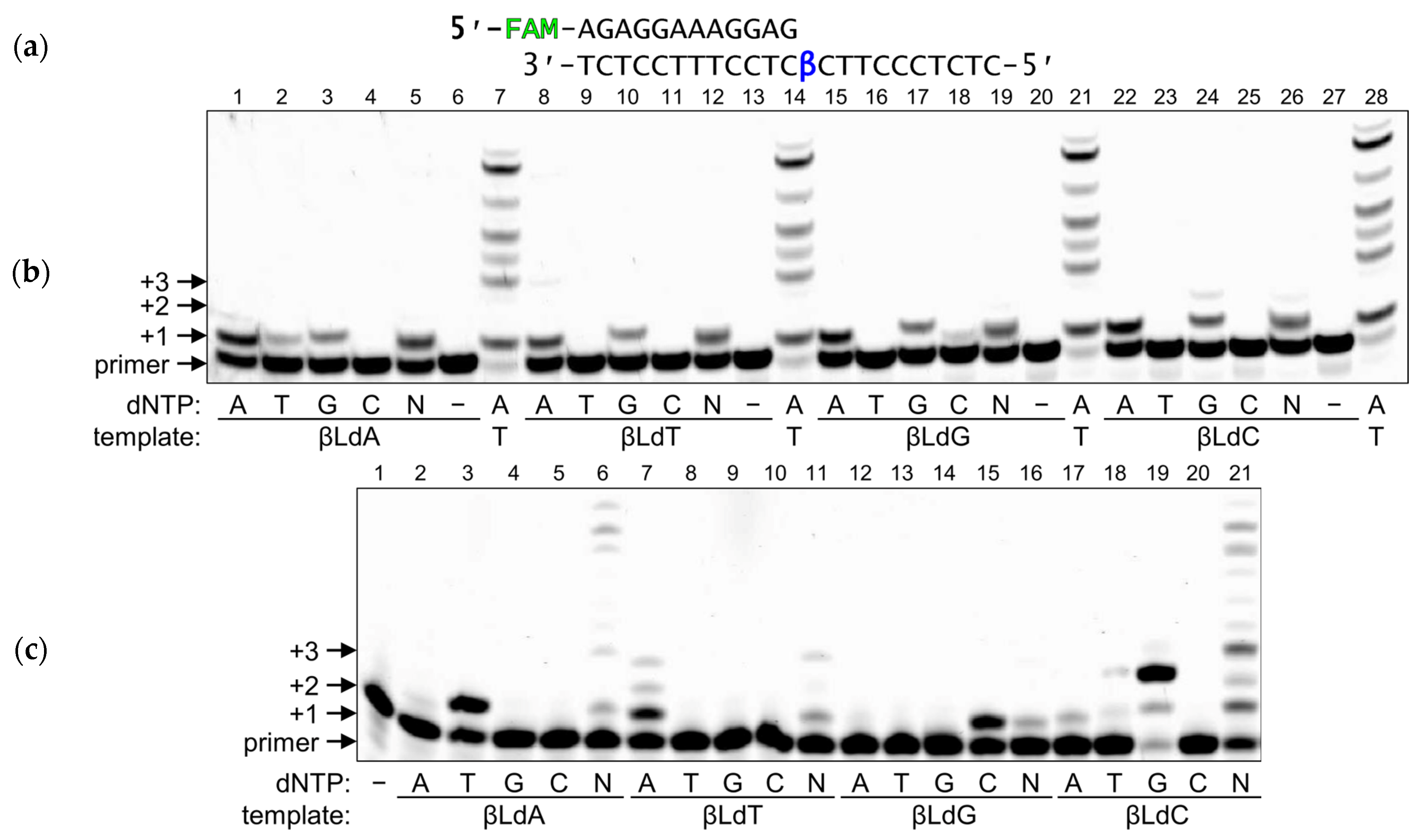
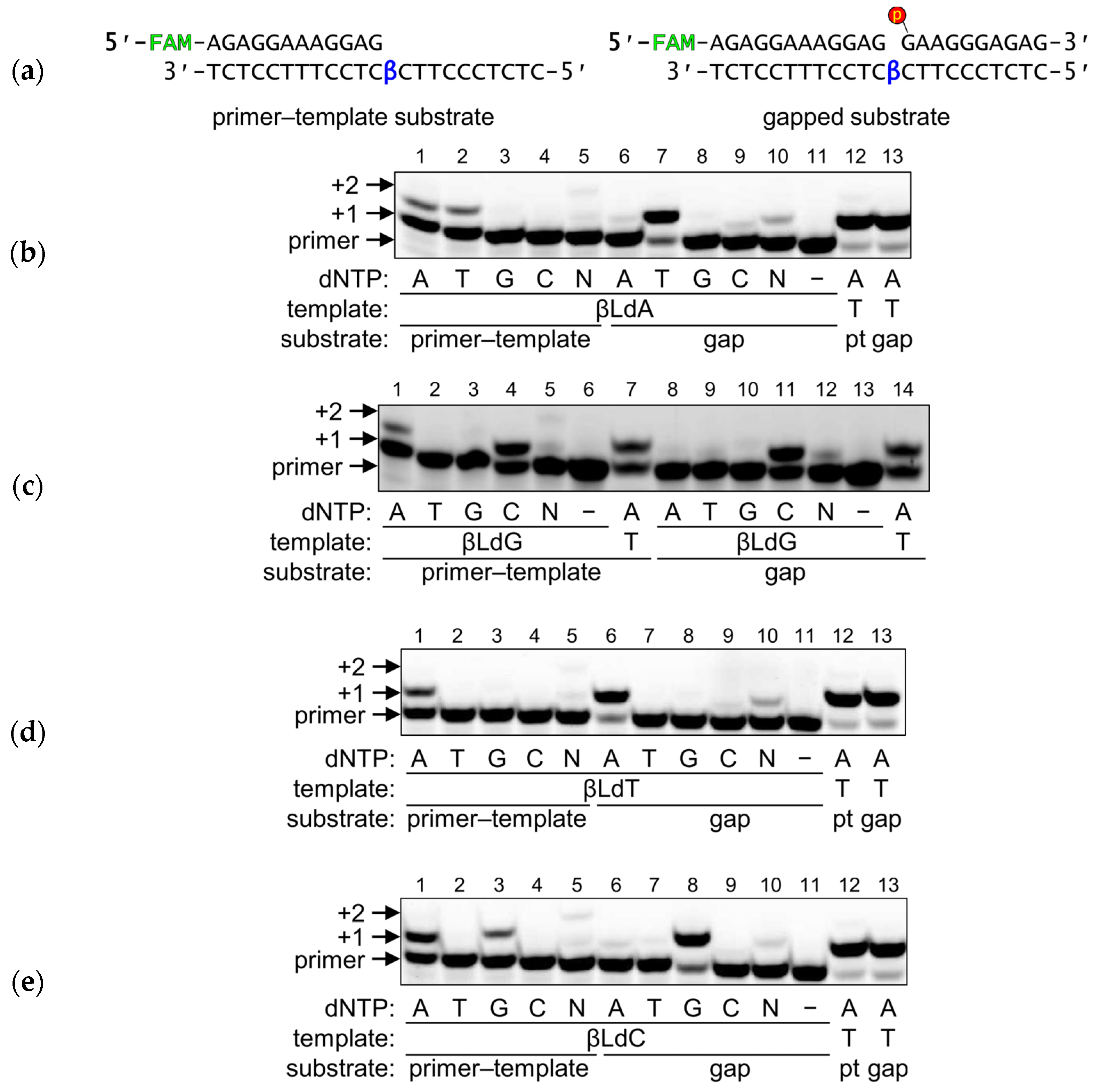
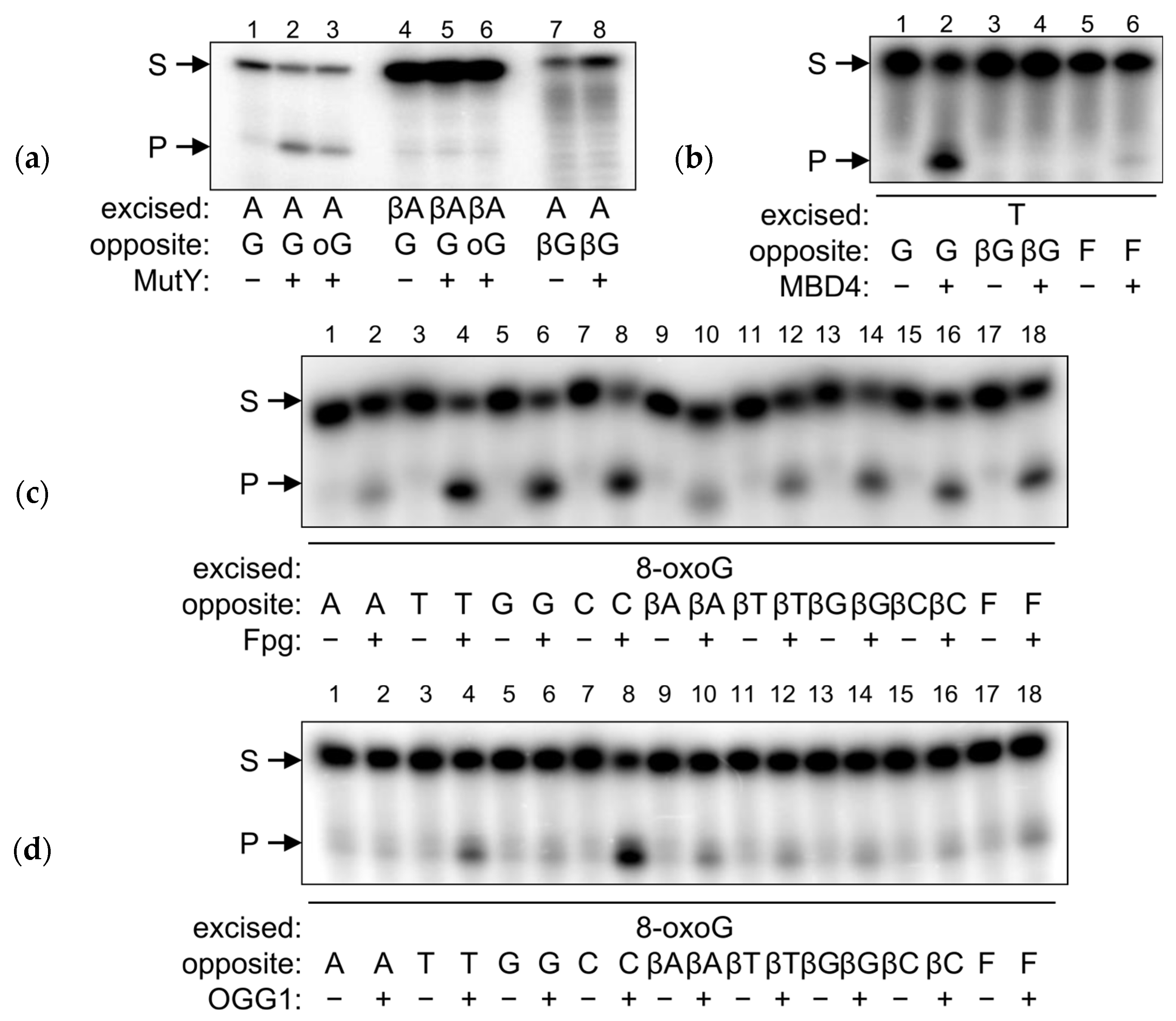
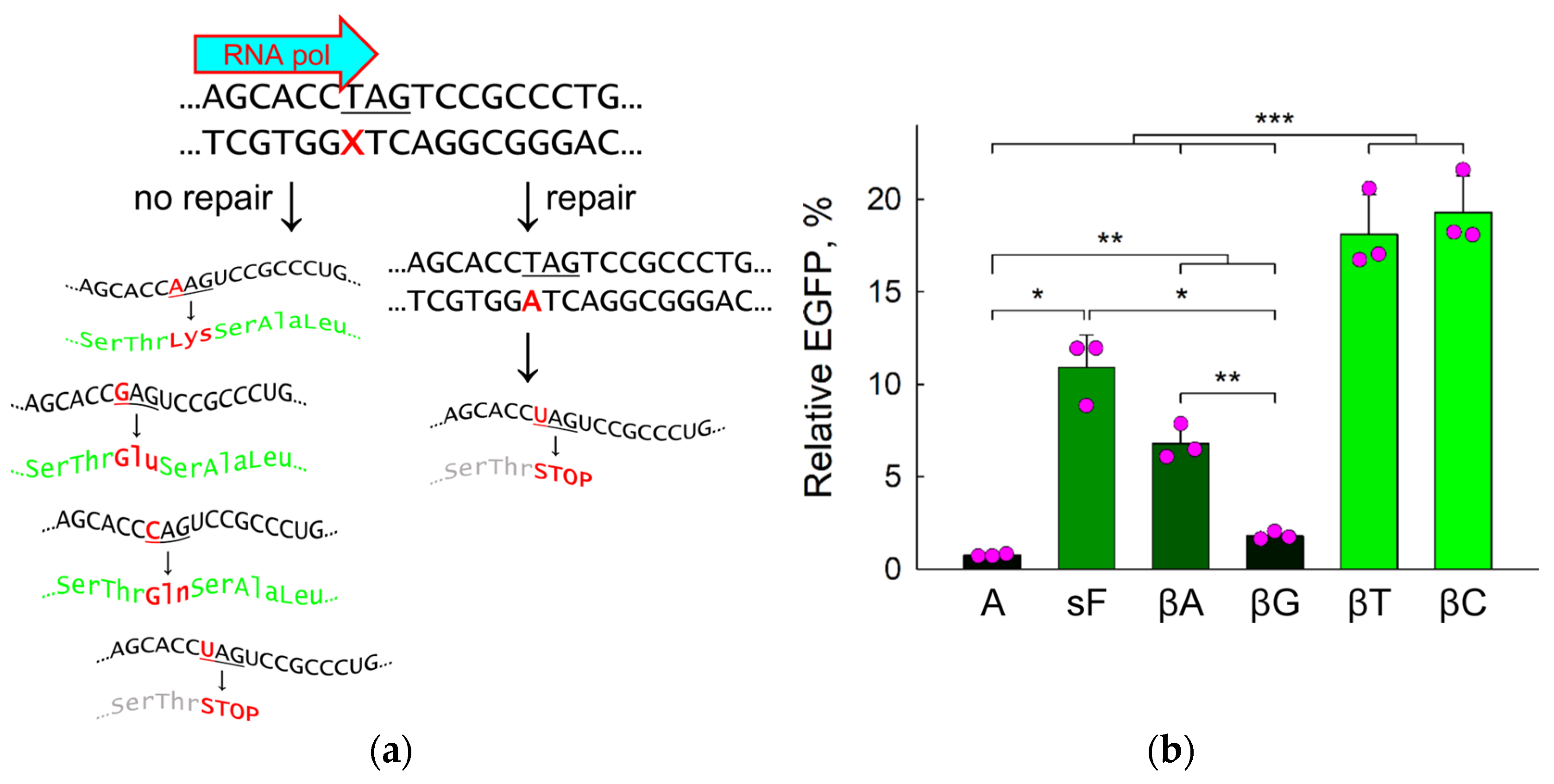
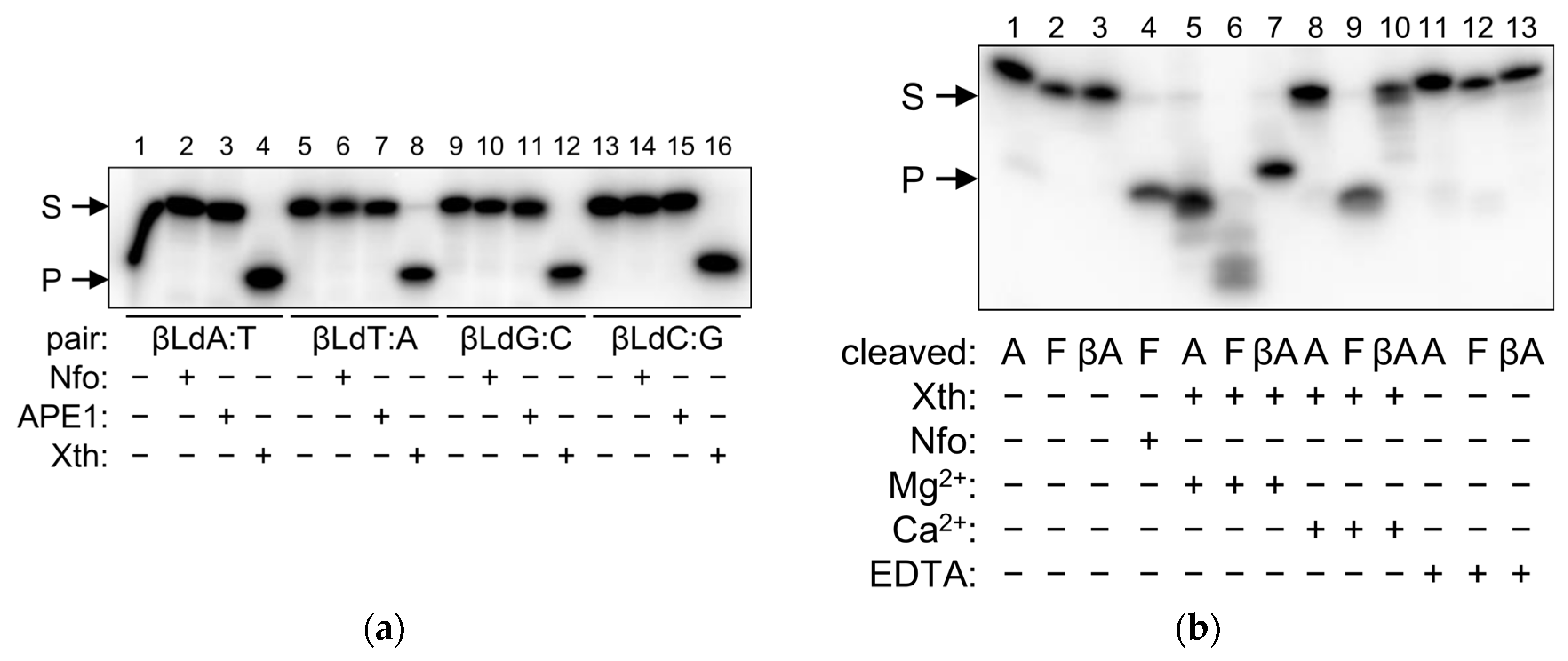
| Template | dNTP | KM, µM | kcat, s−1, ×104 | kcat/KM, µM−1 × s−1, ×106 |
|---|---|---|---|---|
| βLdA | dATP | 450 ± 130 | 24 ± 3 | 5.3 ± 1.7 |
| βLdT | dATP | n/s b | n/s | 0.85 ± 0.04 |
| βLdG | dATP | 570 ± 180 | 12 ± 2 | 2.1 ± 0.8 |
| βLdC | dATP | n/s | n/s | 1.6 ± 0.1 |
| βLdC | dGTP | n/s | n/s | 0.78 ± 0.07 |
| βLdT | dGTP | n/s | n/s | 0.73 ± 0.03 |
| βLdG | dGTP | n/s | n/s | 0.77 ± 0.04 |
| βLdA | dGTP | n/s | n/s | 1.6 ± 0.1 |
| AP c | dATP | 110 ± 30 | 270 ± 30 | 250 ± 70 |
| Template | dNTP | KM, µM | kcat, s−1, ×104 | kcat/KM, µM−1 × s−1, ×105 |
|---|---|---|---|---|
| βLdA | dATP | 64 ± 16 | 32 ± 2 | 5.0 ± 1.3 |
| βLdT | dATP | 53 ±18 | 100 ± 10 | 19 ± 7 |
| βLdG | dATP | 57 ± 9 | 38 ± 1 | 6.7 ± 1.1 |
| βLdC | dATP | 46 ± 11 | 210 ± 10 | 46 ± 11 |
| βLdA | dTTP | n/s b | n/s | 0.54 ± 0.02 |
| βLdG | dCTP | 120 ± 20 | 270 ± 20 | 23 ± 4 |
| βLdC | dGTP | 200 ± 50 | 98 ± 10 | 4.9 ± 1.3 |
| AP c | dATP | no significant incorporation | ||
| Template | dNTP | KM, µM | kcat, s−1, ×104 | kcat/KM, µM−1 × s−1, ×104 |
|---|---|---|---|---|
| βLdT | dATP | 100 ± 20 | 240 ± 10 | 2.4 ± 0.5 |
| βLdA | dTTP | 67 ± 12 | 410 ± 20 | 6.1 ± 1.1 |
| βLdG | dCTP | 17 ± 3 | 510 ± 20 | 30 ± 5 |
| βLdC | dGTP | 37 ± 9 | 210 ± 20 | 7.3 ± 1.9 |
| AP b | dATP | 2.9 ± 1.5 | 4.4 ± 0.2 | 1.5 ± 0.8 |
| Substrate | Fpg | OGG1 | ||
|---|---|---|---|---|
| KM, nM | kcat, min−1 | kcat/KM, nM−1 × min−1, ×103 | k2, min−1 | |
| 8-oxoG:C | 9.3 ± 1.3 | 0.34 ± 0.01 | 37 ± 5 | 1.8 ± 0.2 |
| 8-oxoG:βLdC | 42 ± 11 | 0.14 ± 0.02 | 3.3 ± 1.0 | 0.047 ± 0.006 |
| 8-oxoG:F | 36 ± 18 | 0.13 ± 0.03 | 3.6 ± 2.0 | 0.038 ± 0.002 |
Disclaimer/Publisher’s Note: The statements, opinions and data contained in all publications are solely those of the individual author(s) and contributor(s) and not of MDPI and/or the editor(s). MDPI and/or the editor(s) disclaim responsibility for any injury to people or property resulting from any ideas, methods, instructions or products referred to in the content. |
© 2024 by the authors. Licensee MDPI, Basel, Switzerland. This article is an open access article distributed under the terms and conditions of the Creative Commons Attribution (CC BY) license (https://creativecommons.org/licenses/by/4.0/).
Share and Cite
Yudkina, A.V.; Kim, D.V.; Zharkov, T.D.; Zharkov, D.O.; Endutkin, A.V. Probing the Conformational Restraints of DNA Damage Recognition with β-L-Nucleotides. Int. J. Mol. Sci. 2024, 25, 6006. https://doi.org/10.3390/ijms25116006
Yudkina AV, Kim DV, Zharkov TD, Zharkov DO, Endutkin AV. Probing the Conformational Restraints of DNA Damage Recognition with β-L-Nucleotides. International Journal of Molecular Sciences. 2024; 25(11):6006. https://doi.org/10.3390/ijms25116006
Chicago/Turabian StyleYudkina, Anna V., Daria V. Kim, Timofey D. Zharkov, Dmitry O. Zharkov, and Anton V. Endutkin. 2024. "Probing the Conformational Restraints of DNA Damage Recognition with β-L-Nucleotides" International Journal of Molecular Sciences 25, no. 11: 6006. https://doi.org/10.3390/ijms25116006






